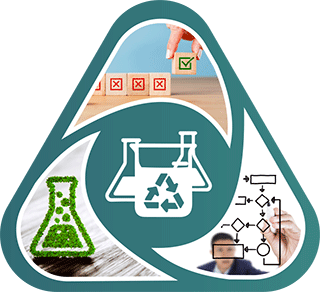
Much of the work carried out by DTT is in support of the National Toxicology Program (NTP), an interagency partnership of the Food and Drug Administration, National Institute for Occupational Safety and Health, and NIEHS.

Public Health Significance
Hazardous agents often are replaced by new or existing substances due to factors such as public pressure, economic consequences, and regulatory bans. However, information about a given replacement’s potential to lead to similar or greater harm to human health than the original substance — a scenario called a regrettable substitution — is often limited or not available.
In the United States and worldwide, there have been many instances of regrettable substitutions. For example, DDT (dichlorodiphenyltrichloroethane), a pesticide banned by the Stockholm Convention due to its biological persistence, bioaccumulation, and toxicity, was replaced by organophosphate pesticides, which are associated with acute and chronic health effects, including developmental neurotoxicity.
Currently, limited emphasis is placed on developing strategies and methods that proactively evaluate potential human health effects of alternative substances.
Research Objectives
The Safe and Sustainable Alternatives (SSA) research is structured around the following three objectives:
- Explore and establish stakeholder relationships and collaborations that identify critical gaps, opportunities, and strategies for proactive toxicological assessments of substances of public health concern.
- Identify and qualify effective tools and approaches through case studies that establish translational utility and refine proactive strategies for evaluation of alternative substances.
- Evaluate the relative potential for human health effects resulting from exposure to select alternative substances.
This research aims to provide quantitative, actionable information to industry, regulators, and the public in an efficient and timely manner.
Background
Building on the NIEHS Division of Translational Toxicology’s strong reputation for advancing trusted science that informs public health decision-making, the SSA promotes research approaches that aid the identification of safer alternatives. This is being accomplished through partnerships with scientists from industry; local, state, federal, and international governments; nongovernmental organizations; and academia.
Through computational and predictive research tools, bioactivity screening, in vitro models, and in vivo studies, the SSA will advance strategies to improve understanding of the potential for adverse human health effects posed by replacement substances. Communication with stakeholders will identify gaps in existing safety evaluation strategies, which will guide future efforts to prevent disease.
The SSA research objectives intersect with those of multiple external partners, such as the U.S. Environmental Protection Agency, the European Chemicals Agency, Association for the Advancement of Alternatives Assessment, and GreenScreen. There also are many local, state, federal, and international agencies that are interested in addressing the problem of regrettable substitutions but lack the requisite expertise and resources.
In addition, the private sector, including individual corporations, industry advocacy groups, trade associations, and professional societies, seeks enhanced information on suitable alternatives. Various external groups are working in the areas of product safety and sustainability and environmental impacts. The SSA will expand collaborative efforts with these organizations and further evolve emerging methodologies.
Select Studies
| Study | Description | Findings / Supporting Files |
|---|---|---|
| PFAS In Vivo ADME-Tox Studies | Multiple research studies addressing the ADME (absorption, distribution, metabolism, and excretion) and toxicity of per- and polyfluoroalkyl substances (PFAS) |
|
| PFAS Bioaccumulation Modeling | Bioaccumulation of PFAS (e.g., complex product mixtures of aqueous film-firming foams-AFFFs) using in vivo and in vitro model systems. |
|
| Human Liver Toxicity & Disease Modeling from PFAS and AFFF Exposures | Thirty (30) PFAS, AFFF, and drug substances were evaluated using human liver tissue models, machine learning of cell morphologies, and high throughput transcriptomics |
|
| Bisphenols | Multiple research studies addressing the ADME and toxicity of bisphenol analogues |
|


